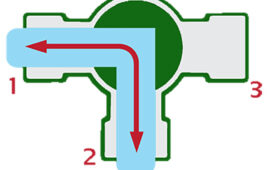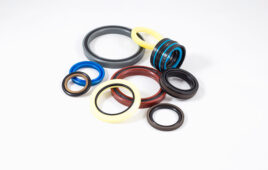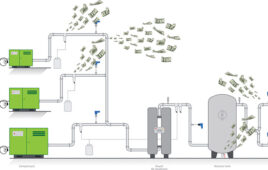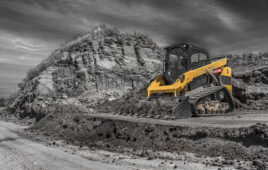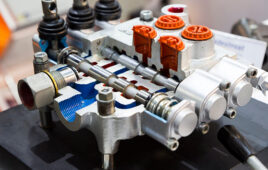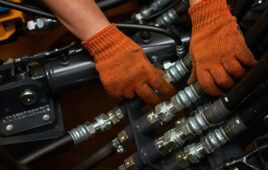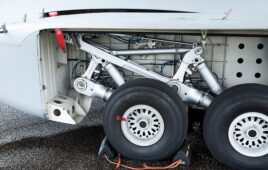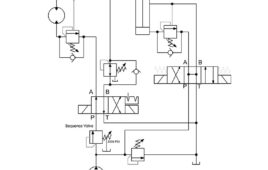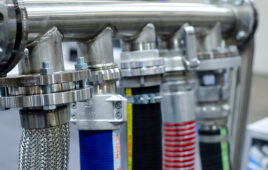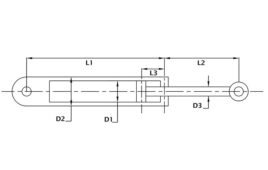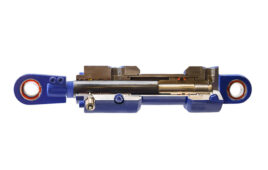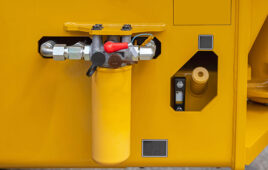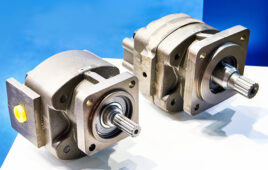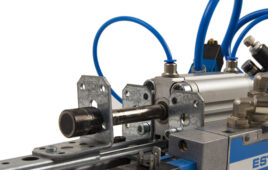By Josh Cosford, Contributing Editor When buying a cylinder repair kit, you generally expect to open a plastic bag filled with O-rings, rod seals, end seals and other synthetic rubber bits used to freshen up an old air or hydraulic cylinder. Often, we call such an assembly of parts a seal kit, which completely forsakes […]
How do three-way hydraulic valves work?
By Josh Cosford, Contributing Editor Three-way valves, common and versatile tools in fluid power, demonstrate their precision by effectively diverting, selecting, or mixing three flow paths as the circuit requires. These valves, available in lever or solenoid actuation, are widely used for directional control. Their construction style varies, ensuring suitability for diverse applications. The three-way…
12 tips for leakage prevention through proper sealing design and selection
By Josh Cosford, Contributing Editor Seals used for fluid power applications are highly varied and specific to each component and application. From simply sealing pressurized air from atmospheric air for pneumatic valves to preventing hydraulic oil from leaking into waterways from the rudder cylinder on watercraft, there are few conditions in which a fluid power […]
Creating a compressed air leak management plan
Measuring and repairing compressed air leaks can easily reduce energy costs by 10 to 20%. Compressed air is used in factories all over the world to control machines, processes, and pneumatic equipment. It is a safe and easily available medium and can be used in all possible places via hoses and pipes. However, compressed air […]
A primer on hydraulic hose bend radius
By Josh Cosford, Contributing Editor Hydraulic hose bend radius, quite simply, describes how tightly circular a hydraulic hose can bend. More importantly, designers and technicians wish to know the minimum bend radius a hose handles while maintaining integrity. Although one might easily force a hose into a tight radius during installation, its design and construction […]
What is burst pressure for hydraulic hose?
By Josh Cosford, Contributing Editor Hydraulic hoses are designed to withstand much higher pressure than expected during regular operations, which everyone will agree is good. Should your machine’s working pressure fall within a typical 3,000 psi, you’d be little comforted by a hose designed to burst at 3,100 psi. The slightest pressure spike would lead […]
A primer on hydraulic oil analysis
This article is the first in our series on hydraulic oil analysis programs. Hydraulic oil is the lifeblood of your hydraulic system, circulating primarily as a power transmission medium but also acting to lubricate, cool, seal and help remove contamination. Without oil, your hydraulic system is just a comatose pneumatic system, lying lifeless with no […]
When should you use hydrostatic pumps?
The term hydrostatic refers to the fundamental concept we hold dear in fluid power, which is that confined hydraulic fluid under pressure exists in equilibrium and balance. Although hydraulic fluid does no more than hold objects stationary without the active application of force through a pumping device, the concept is entirely different than hydrodynamics, which […]
Industrial hydraulic maintenance tips
Spring is around the corner, although if you’re located near the Great Lakes, you might need convincing that winter ever came this year at all. Regardless, the page on my desktop calendar is March, which makes a perfect time to schedule a spring maintenance session for your industrial hydraulic equipment. Even if you enjoy a…
Is it possible to max out pressure?
I’ve written much about pressure lately, discussing subjects such as the upper reasonable limits in hydraulics to shockingly high-pressure fuel injection systems. Regarding current or conceivable limits, I see no reason we can’t exceed 7,000 bar with commercially available machinery, such as water jet cutters. For the sake of simplicity and lower digits, I’m expressing…
7 signs your hydraulic valve has failed
By Josh Cosford, Contributing Editor There are very few hydraulic systems operating without directional valves, and aside from modern technologies that can make do with a servo-driven pump and a single actuator, you’ll be hard-pressed to think of a way to control actuators without them. They are responsible for managing the flow and direction of…
Distributed electro-pneumatics streamline equipment designs
Machinery builders and OEMs save space and improve functionality by applying electro-pneumatic I/O and solenoid systems throughout their equipment. By: Chip McDaniel, AutomationDirect For machine builders and original equipment manufacturers (OEMs) alike, there is an increasing push to deliver smarter, more modular, and physically compact systems. Among the many design choices required to make this […]
Safety tips for connecting and disconnecting hydraulic hose
By Josh Cosford, Contributing Editor Hydraulic hoses are crucial in various fluid power industries, helping power heavy machinery and equipment by providing the very conduit through which hydraulic fluid flows. The integrity of these systems relies heavily on the proper connection and disconnection of hydraulic hoses, as mishandling hydraulic hoses can lead to severe accidents […]
Where are hydraulics used in aviation?
By Josh Cosford, Contributing Editor In the dynamic and intricate world of aviation, where precision and reliability are paramount, hydraulics plays a pivotal role in ensuring the smooth functioning of various aircraft systems. Hydraulics, the science of transmitting force through liquids, finds extensive application in aviation due to its ability to generate powerful and controlled…
A primer on when to use pneumatic vacuum pumps
By Josh Cosford, Contributing Editor Vacuum technology is the quintessential method for safe and careful material handling in various industries, from packaging to glass manufacturing. Vacuum cups and pads are gentle and soft, lifting even the largest material while barely contacting the surface. By creating a vacuum inside the cup, the pressure differential draws the […]
Is the sequence valve obsolete?
By Josh Cosford, Contributing Editor We don’t hear much anymore regarding sequence valves, and probably for good reason. A sequence valve is like a self-regulating inline relay that opens when work pressure overrides the spring setting. It’s a form of hydraulic automation that provides sequential operation for two or more functions using one fluid supply…
What is a lubricated compressor banana curve?
If you are carefully selecting your new compressors by looking at Compressed Air & Gas (CAGI) data sheets, you should be commended. Use of these sheets are a great way to compare compressor energy and flow characteristics between brands of compressors. In this way, you can choose the most efficient machine for your use and […]
What is the difference between industrial and hydraulic hose?
By Josh Cosford, Contributing Editor Technically speaking, hydraulic hose is often also industrial hose, but for the sake of this article, I will define what makes them different in both construction and application. We could call out industrial hose for its use in mobile machinery as well, although I’m not here to make beef, so […]
Calculating hydraulic cylinder column strength
Hydraulic cylinder column strength is essential in most applications. Here, we go into some basic specifications to consider when selecting, mounting and using hydraulic cylinders. By Josh Cosford, Contributing Editor As someone who helps run a cylinder manufacturing company, I can tell you that hydraulic cylinder column strength is a poorly understood concept by designers…
5 ways to control hydraulic cylinder speed
By Josh Cosford, Contributing Editor Hydraulic cylinders are unique in that they’re nearly 100% volumetrically efficient, although they are subjected to losses from mechanical efficiency. This means that nearly all the fluid stuffed into them results in proportional linear movement, but only some of the pressure required by them is to move their loads. Regardless,…
What are the symptoms of a clogged hydraulic filter?
By Josh Cosford, Contributing Editor In the case of hydraulic systems, efficiency and reliability are paramount, and these systems, used in various industries, rely on the seamless flow of hydraulic fluid to power heavy machinery and equipment. One crucial component that ensures the reliable operation of the pumps, valves and actuators is the hydraulic filter. […]
Troubleshooting Challenge: truck assembly line hydrostatic transmission overheating
Contributed by Robert Sheaf • Founder of CFC Industrial Training In this month’s Troubleshooting Challenge, a truck assembly line has a lift system to elevate the transmission into position for bolting it to the engine. The operator complained to the maintenance department that the system was very sluggish to respond to the forward and…
How do I know I’ve oversized my pump?
By Josh Cosford, Contributing Editor Oversizing your hydraulic pump is a relatively common error by beginner fluid power professionals or, more likely, entirely untrained individuals tasked with maintaining machinery. Everyone wears many hats these days, so don’t take it personally if you’ve inherited a role that requires skills above your pay grade. More than once […]
How can you tell if you have air in your hydraulic oil?
By Josh Cosford, Contributing Editor Hydraulic systems are the workhorses of many industries, powering everything from heavy machinery to manufacturing equipment. The lifeblood of these machines is hydraulic oil, which transmits power, dissipates heat, carries away contamination and lubricates components. However, just like any other fluid-based system, hydraulic systems are susceptible to unique issues, including […]
5 reasons your pneumatic cylinder isn’t working
By Josh Cosford, Contributing Editor Pneumatic cylinders are essential in various industrial applications, providing the mechanical force needed to move loads, automate equipment, and perform countless other tasks. However, pneumatic cylinders encounter issues that impede their performance like other machine components. When your pneumatic cylinder isn’t working as expected, it can lead to downtime, reduced […]


